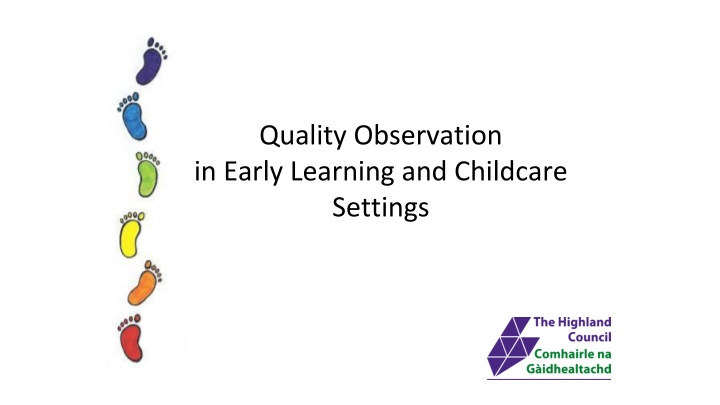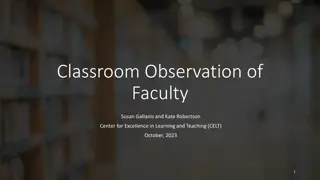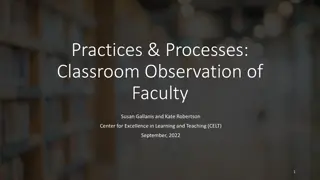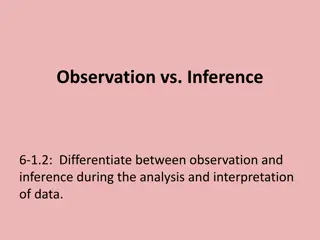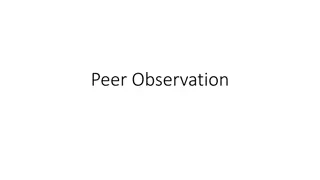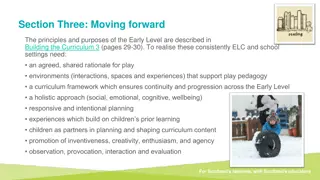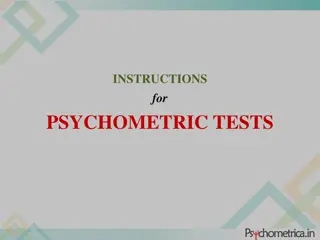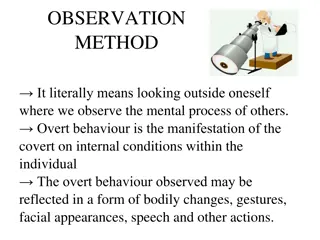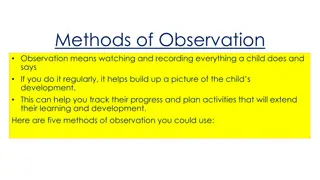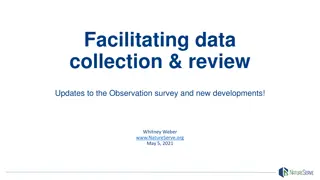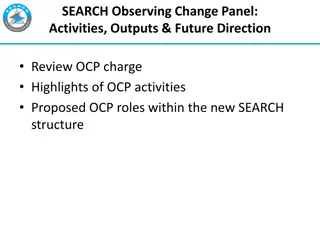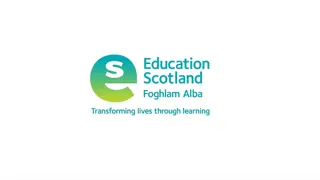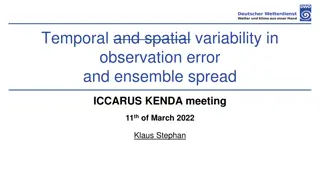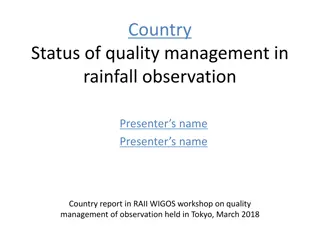Quality Observation in Early Learning Settings
This session delves into the significance of observation, interpretation, and documentation of learning in early childcare settings. It discusses the Realising the Ambition approach, emphasizing the planning cycle, reflective practices, and understanding children's interests and development. The importance of continuous observation throughout a child's time in the setting is highlighted, focusing on gaining insight into their abilities, preferences, and learning styles.
Download Presentation

Please find below an Image/Link to download the presentation.
The content on the website is provided AS IS for your information and personal use only. It may not be sold, licensed, or shared on other websites without obtaining consent from the author.If you encounter any issues during the download, it is possible that the publisher has removed the file from their server.
You are allowed to download the files provided on this website for personal or commercial use, subject to the condition that they are used lawfully. All files are the property of their respective owners.
The content on the website is provided AS IS for your information and personal use only. It may not be sold, licensed, or shared on other websites without obtaining consent from the author.
E N D
Presentation Transcript
Quality Observation in Early Learning and Childcare Settings
Quality Observation in Early Learning and Childcare Settings Aims for the session: To explore what Realising the Ambition says about observation, interpretation and documentation of learning. To explore why, what and how we observe children To revisit the criteria for written observations To explore how children make progress and how we evidence it To explore different types of documented observations
Quality Observation in Early Learning and Childcare Settings Realising the Ambition highlights that the planning cycle... . ...involves us reflecting on our observations. Some of these will be written down, but there will be other things that we have noticed and remembered during the day. Spending time reflecting on observations enables us to consider what children are interested in or curious about, what ideas they are exploring, or skills they are developing. . Realising the Ambition, p 66
Quality Observation in Early Learning and Childcare Settings In your current practice: When and how do you observe children?
Quality Observation in Early Learning and Childcare Settings When and how do you observe? All of the time! Our job is to observe the children from the minute they arrive to the minute they leave the setting. Observing children is not about setting up an activity for assessment.
Quality Observation in Early Learning and Childcare Settings Highland Council Guidance Key Learning Observations (KLOs) in Early Learning and Childcare
Why observe? - To gain knowledge of what a child can do. - To understand their strengths. - To understand where a child likes to learn best. - To understand how a child is disposed to learning. Want to read more? L. Sancisi & M. Edgington (2015) Developing High Quality Observation, Assessment and Planning in the Early Years - To understand their stage of development.
Quality Observation in Early Learning and Childcare Settings Why do we observe? Unless practitioners observe children with care and attentiveness, how can they possibly know what the child is interested in, what he can do, and what help he needs? Fisher 2016
Quality Observation in Early Learning and Childcare Settings What do we observe? Noteworthy, relevant learning and progress. What do the child s actions, emotions and words tell you about their development and learning?
Quality Observation in Early Learning and Childcare Settings Leaving a parent happily for the first time. What do the child s actions, emotions or words tell you about their development and learning? Developing the confidence to approach a familiar EYP for help or to play with them. A child who previously needed encouragement to sustain engagement, for example in block play, is now independently able to engage in this play for longer periods of time. A child who has delayed speech & language has learnt and is using new vocabulary.
Quality Observation in Early Learning and Childcare Settings It is good to know that children are enjoying playing with the mud kitchen, but it is much more useful to notice the extent to which a child is curiously and creatively exploring how textures change when materials are mixed together, or is interested in transporting particular materials from one part of the garden to another. Learning focussed observations help us to understand the child s interests and stage of development. Realising theAmbition, p 66
Quality Observation in Early Learning and Childcare Settings How do we observe? Observation is about really listening to children and looking at what their play has to tell us. Education Scotland
Quality Observation in Early Learning and Childcare Settings The Observation Cycle
Quality Observation in Early Learning and Childcare Settings Observation can therefore be seen as noticing and trying to interpret what the child s actions, emotions and words mean in terms of what they are learning. We can observe what they are mastering and what they still need help, guidance and practice with. Our role includes noticing what the child does and how this might be changing over time. Realising the Ambition, p 65
Quality Observation in Early Learning and Childcare Settings What is noteworthy learning? Consider what you understand by noteworthy learning . Identify an example of noteworthy learning you have observed recently.
Quality Observation in Early Learning and Childcare Settings Identifying noteworthy learning Watch the clip and identify what the noteworthy learning might be. https://www.youtube.com/watch?v=ut12pmdxiqg
Quality Observation in Early Learning and Childcare Settings Analyse (What does this tell me? What does this mean?) Is there engagement? Is there evidence of learning? Is there evidence of progress? Are you going to: Add an individual observation to a profile Inform planning Bin them!
Quality Observation in Early Learning and Childcare Settings It is the responsibility of all EYPs in a setting to record children s learning through observations. Key workers are responsible for collating this information for their group of key children. The Role of the Key Worker (Highland Council)
Quality Observation in Early Learning and Childcare Settings Improve (What will I do now?) Effective observation should always lead to Analysing how much and how well a child has learned. Considering what changes could be made to interactions, experiences and spaces to support next steps in learning and deepen interests.
Quality Observation in Early Learning and Childcare Settings Observation is a key part of Play Pedagogy. Observation and documentation of learning responsive and intentional planning, assessment and evaluation observation and documentation of learning What do the children s actions, emotions and words tell you about what they require from you and others in terms of interactions, experiences, and the different spaces they need to grow and develop in every way? implementatio n For Scotland's learners, with Scotland's educators
Quality Observation in Early Learning and Childcare Settings Improve (What will I do now?) How do you show progression within Profiles ?
Quality Observation in Early Learning and Childcare Settings Criteria for Effective Written Observations Personalised Focus on learning and the skills being developed Note progression Specific Worded positively Dated
Quality Observation in Early Learning and Childcare Settings Activity To review where you are now Select one of your 4 year old s profiles Review the observations you have recorded in one or two of the core areas of Literacy, Numeracy, Health and Wellbeing
Quality Observation in Early Learning and Childcare Settings Ask yourself the following questions about your written observations? Are they personalised? Are they focussed on learning and the skills being developed? Do they note progression? Are they specific? Are they worded positively?
Quality Observation in Early Learning and Childcare Settings Ethical Observations Parent/carers need to understand why we observe and what we are recording. Written consent should be provided by parents/carers. Children should have an understanding of why we make notes and take photos. Writing an observation should never come in the way of supportive adult interaction. When observing children, practitioners are mindful of the child s rights. Every child should be valued, included and supported. Equitable and anti-discriminatory practice are essential.
Quality Observation in Early Learning and Childcare Settings Profiling and Reporting in Highland
Profiling and Reporting in Highland Monitoring and Tracking: The Profile Managers should have ongoing monitoring and tracking conversations with EYPs, using the profile (the Monitoring The Profile format can also be used) to evaluate: - Where is the child in their learning? - What evidence is there to demonstrate this? - How does the profile show progression? - Where are the child s next steps?
Quality Observation in Early Learning and Childcare Settings Types of Observations Written Photographs Work Samples Time Samples
Quality Observation in Early Learning and Childcare Settings Photographs Should capture the child s learning Must always include a written note of the child s learning Can show progress in learning over time
Quality Observation in Early Learning and Childcare Settings Work Samples These can be drawings, paintings, writing, cutting etc. which demonstrate noteworthy learning or skills Must always include a written note of the child s learning
Quality Observation in Early Learning and Childcare Settings Time Sample Can be used to track a child s actions or behaviour at regular intervals Can be used to observe an area of the setting at regular intervals
Quality Observation in Early Learning and Childcare Settings Self-evaluation The three self-evaluative questions are a useful starting place: How are we doing? How do we know? What are we going to do now?
Quality Observation in Early Learning and Childcare Settings Self- Evaluation
Quality Observation in Early Learning and Childcare Settings More resources can be found on the Early Learning and Childcare blog and the National Improvement Hub.
Quality Observation in Early Learning and Childcare Settings Further Reading to support professional development: How good is our early learning and childcare? (2016) Realising the Ambition (2020) Interacting or Interfering? J. Fisher (2016) C. Nutbrown, Respectful Educators Capable Learner (1996) M. Drummond (1998) in S. Smidt, Observing Young Children (2010) The Children in Scotland publication: The Cycle of Observation, Assessment and Planning (2013) K. Brodie, Observation, Assessment and Planning in the Early Years (2015)
Quality Observation in Early Learning and Childcare Settings
